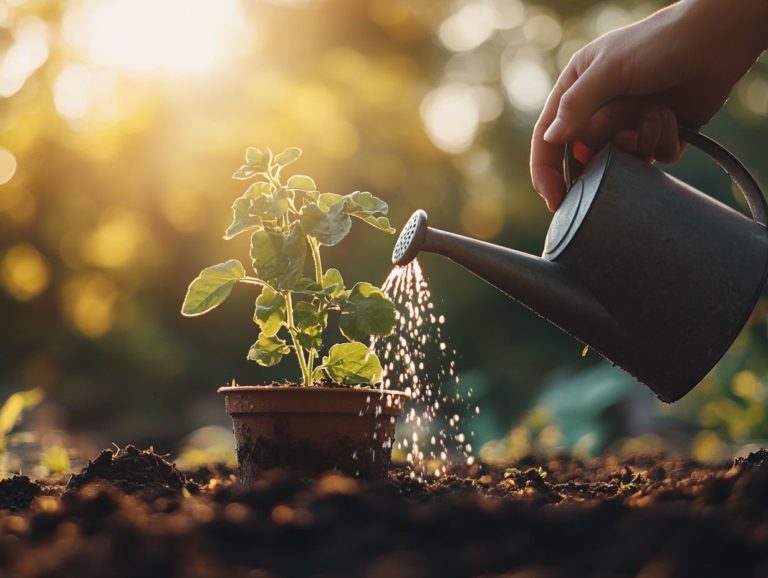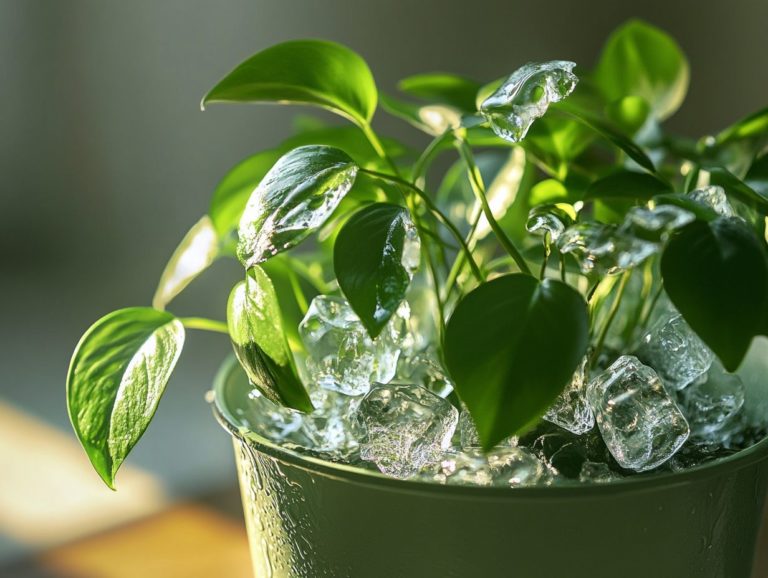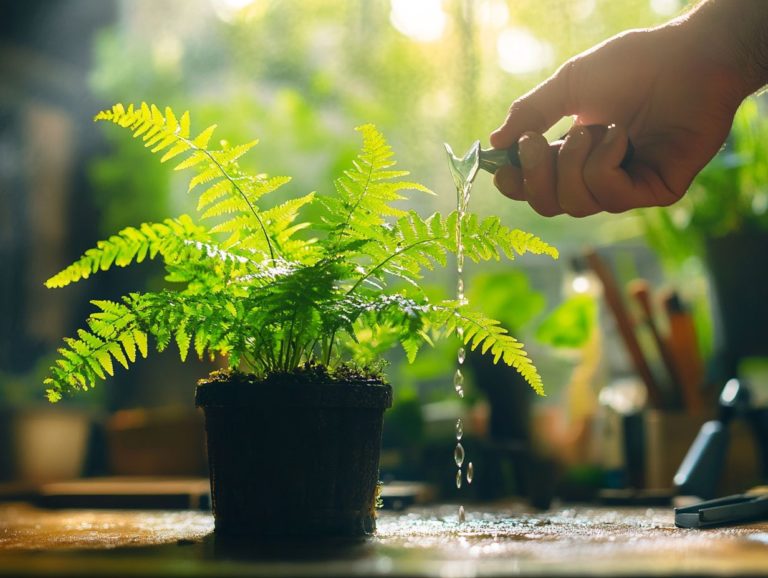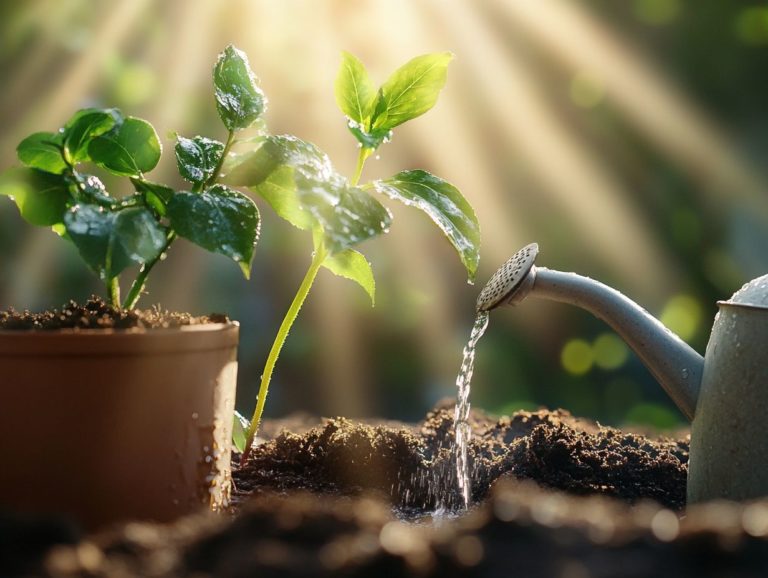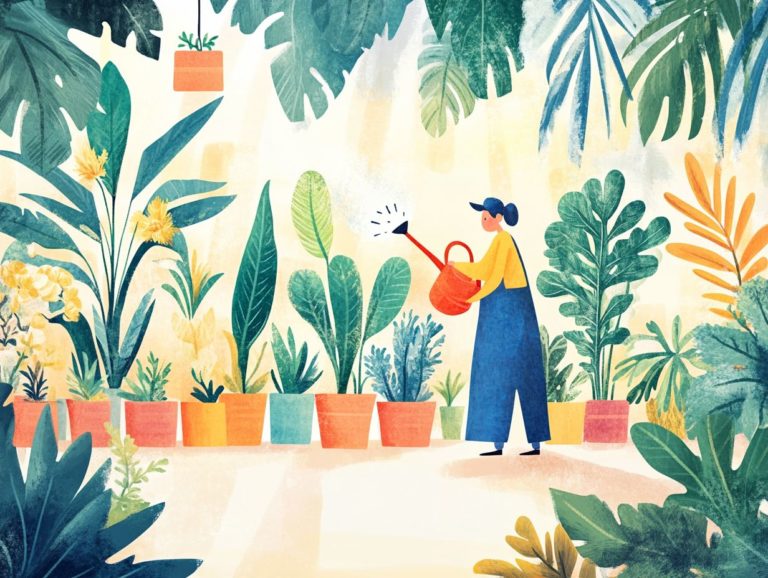7 Indoor Plants That Love Regular Watering
If you’re seeking to enhance your home s ambiance while simultaneously improving air quality, look no further than indoor plants they’re an ideal solution.
This article delves into seven vibrant options that thrive on regular watering, featuring the graceful Peace Lily and the sturdy Spider Plant. It provides essential care tips, including how to recognize when your plants need water and the optimal conditions for their growth.
Embrace the joys of indoor gardening and discover how to keep your green companions thriving and content!
Contents
- Key Takeaways:
- 1. Peace Lily
- 2. Boston Fern
- 3. Spider Plant
- 4. English Ivy
- 5. Chinese Evergreen
- 6. Pothos
- 7. African Violet
- How Often Should These Plants Be Watered?
- How Can You Tell If These Plants Are Getting Too Much or Too Little Water?
- What Are Some Tips for Keeping These Plants Healthy and Happy?
- Frequently Asked Questions
Key Takeaways:
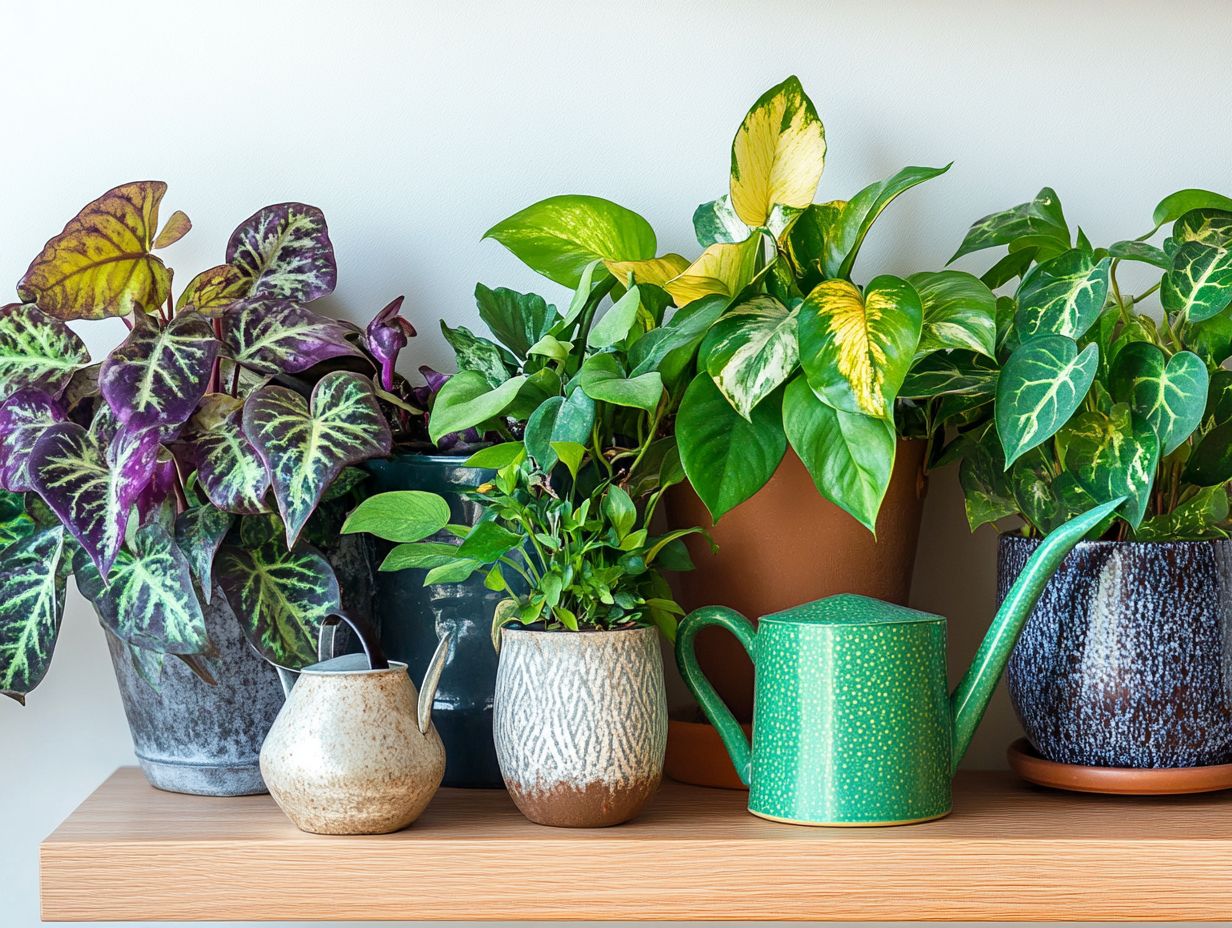
- Regular watering is essential for the growth and health of indoor plants like Peace Lily, Boston Fern, and Spider Plant, which are among the best plants to grow in water.
- These plants thrive in moist conditions with consistent watering.
- Having these plants in your home not only adds beauty but also improves air quality and reduces stress.
1. Peace Lily
The Peace Lily is a cherished choice for indoor greenery, celebrated for its exquisite white blooms and resilience. It flourishes in various light conditions, making it ideal for both novices and seasoned plant aficionados.
To provide optimal light, aim for bright, indirect sunlight or partial shade. Be cautious, as it has a keen sensitivity to harsh, direct rays that can scorch its delicate leaves.
When caring for this elegant plant in water, it’s crucial to change the water regularly to prevent stagnation, ensuring the roots remain healthy and vibrant.
If you’re feeling creative with your containers, consider stylish wall-mounted vessels that elevate your decor while saving space. You could also repurpose items like glass jars or reclaimed pots to add a personal touch to your indoor gardening.
To keep your Peace Lily both healthy and visually striking, periodically wipe the leaves to remove dust. This will enhance its ability to absorb light and showcase its natural beauty.
2. Boston Fern
The Boston Fern is a lush, leafy gem that demands a bit more attention in terms of water quality and humidity. Think of it as a rewarding challenge that enhances your home s interior with vibrant greenery.
This fern loves bright, filtered light. Place it near a window with sheer curtains for the best results, as harsh rays can scorch its delicate fronds. Maintaining a moist environment perhaps through regular misting or using a pebble tray will replicate its natural habitat.
Keep your Boston Fern thriving by ensuring it has well-draining soil and paying attention to water quality. Chlorine and other chemicals can hinder its growth, so choosing the right water is key. By following these straightforward care practices, you’ll watch this vibrant plant flourish and bring a refreshing touch of nature into your home.
3. Spider Plant
The Spider Plant is exceptional, celebrated for its vibrant green leaves and remarkable ease of care. It’s an ideal choice for anyone eager to cultivate greenery, whether in water or soil.
These resilient beauties thrive best in indirect sunlight but can tolerate lower light levels, making them suited for a range of spaces, much like Sansevieria or Ficus Elastica.
If you choose to grow them in water, remember to use a clean container and change the water regularly to prevent stagnation, which can lead to root rot. Ensure that the roots are submerged while keeping the foliage above water for optimal plant health.
Getting new plants is simple; just cut off the offsets that develop and place them directly into water or soil, where they will quickly establish roots. Regularly trim any brown tips on the leaves to maintain their lush appearance and promote overall vitality. Your Spider Plant will remain a stunning centerpiece in your indoor garden.
Start your indoor garden today and enjoy the benefits of fresh air and beauty in your home!
4. English Ivy
English Ivy is a stunning climbing plant that can elevate your indoor spaces with its trailing vines. It thrives effortlessly in various light conditions, especially when grown in wall-mounted vessels or creatively repurposed containers.
For this versatile plant, bright, indirect light is the best choice, allowing its leaves to retain lush green vibrancy without the danger of scorching. It tolerates low light conditions beautifully, making it an excellent choice for dimly lit rooms.
Consider using hanging baskets, wall planters, or even traditional pots for container options. Each choice can enhance its aesthetics and growth significantly!
If you re interested in training your ivy to gracefully ascend walls or trellises, provide a sturdy support structure. Regular pruning encourages a controlled climbing habit, boosting its visual appeal while maintaining optimal health.
5. Chinese Evergreen
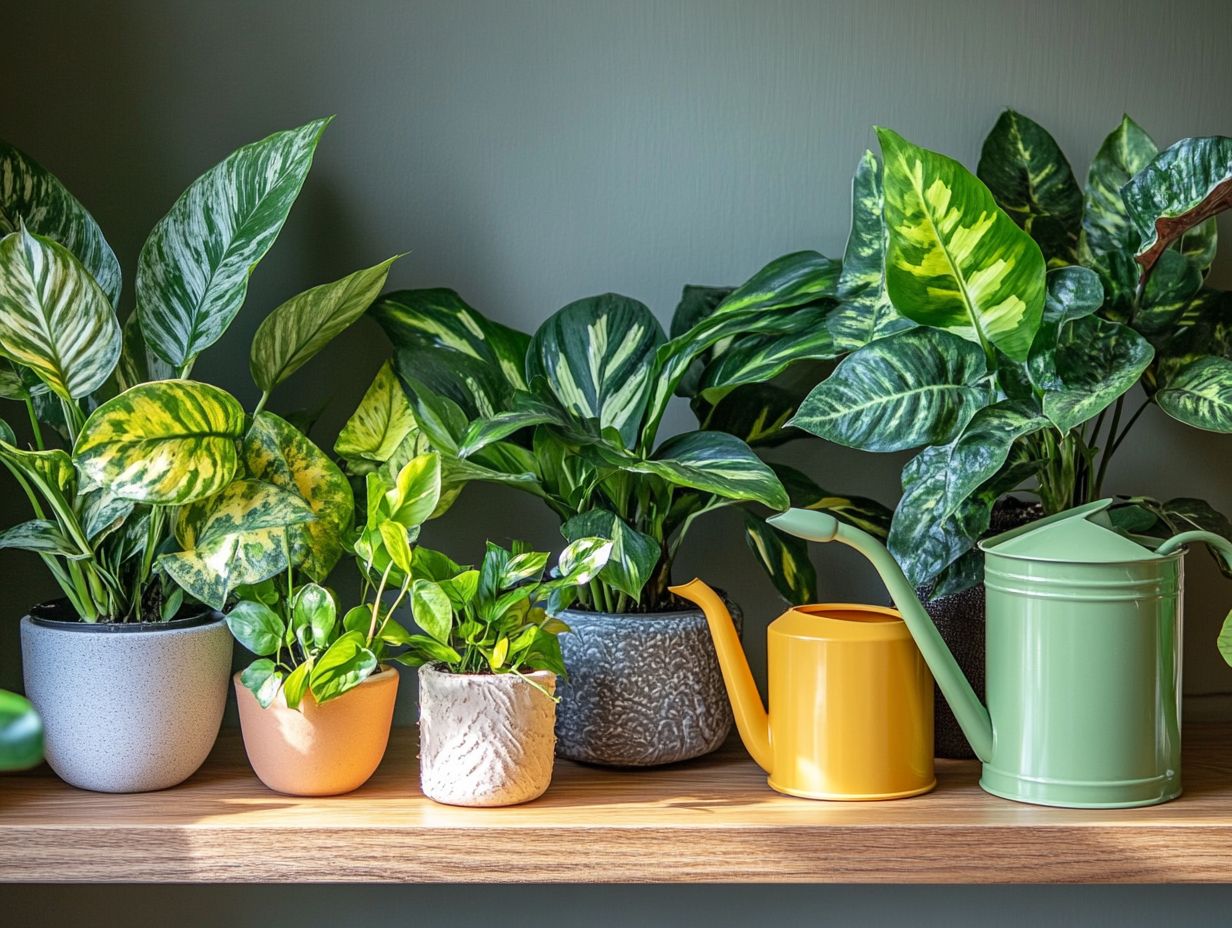
The Chinese Evergreen is your go-to resilient indoor plant, perfectly suited for low-light environments. This makes it an excellent choice for those new to plant care! However, consider the quality of the water you use to keep it healthy and vibrant.
This hardy plant adapts to various light conditions but flourishes in indirect sunlight, which helps prevent leaf scorching. If direct sunlight is unavoidable, filter it through sheer curtains to soften the intensity.
Opt for distilled or rainwater for your Chinese Evergreen s health, as tap water often contains chemicals that aren’t beneficial. Incorporate a simple care routine that includes proper fertilization and water rotation.
- Wipe down leaves to keep dust at bay
- Allow the soil to dry out between waterings
These simple steps will maintain its lush appearance, whether you care for a Pothos or a Dracaena. Regularly check for pests to maintain your plant s health!
6. Pothos
Pothos stands out as one of the most versatile indoor plants, renowned for its cascading vines and remarkable ability to thrive in either water or soil. This makes it perfect for anyone looking for low-maintenance options!
This hardy plant flourishes in diverse environments, allowing even novice gardeners to enjoy its lush foliage without intricate care routines.
When propagating Pothos in water, cut a few healthy stems just below a leaf node and place them in a container filled with water to submerge the nodes just be careful not to cover the leaves. As roots begin to emerge usually within a couple of weeks change the water regularly to prevent algae and bacteria from taking hold.
Thanks to its adaptability, Pothos thrives in various lighting situations, from low light to bright indirect light. Regular pruning promotes bushier growth and enhances its captivating appearance, all while demanding minimal maintenance!
7. African Violet
The African Violet is a remarkable indoor plant, celebrated for its vibrant, colorful blooms and distinct care requirements. To truly thrive, it seeks bright, indirect light and demands attention to specific water quality and fertilization practices that ensure its health and beauty.
To achieve optimal growth, creating the right environment is essential. This plant flourishes under filtered sunlight, steering clear of direct rays that can scorch its delicate leaves. Water quality is paramount; opt for distilled or room-temperature water to prevent mineral buildup that could jeopardize the roots.
Regular fertilization every 4-6 weeks during the growing season using a balanced formula tailored for African Violets will stimulate lush foliage and brilliant blooms. Maintaining high humidity levels and rotating the pot every few weeks will further promote even growth, allowing these enchanting plants to flourish year-round!
How Often Should These Plants Be Watered?
Understanding how often to water your indoor plants, like the Spider Plant, Pothos, and Chinese Evergreen, is essential for their health. Each species has its own unique needs that hinge on factors such as water’s quality and conditions in your home, like light and temperature. You’ll want to pay close attention and adjust your watering routines accordingly.
For example, the Spider Plant prefers that the top inch of its soil dries out between waterings. This typically happens every one to two weeks. On the other hand, Pothos and Chinese Evergreen tend to thrive with a bit more moisture in their surroundings, but if you’re looking for indoor plants that thrive with minimal water, consider other options as well.
Using high-quality water that’s free from chlorine and contaminants not only promotes healthy growth but also reduces the risk of root rot and other issues. Keep an eye out for signs like yellowing leaves or wilting these can signal that it’s time to change the water or tweak your routine.
During warm months, your plants may need more water due to increased humidity. Conversely, winter’s reduced light and cooler temperatures often mean your plants will need less water. By keeping these factors in mind, you’ll ensure your plants maintain their vibrant character throughout the seasons.
What Are the Best Conditions for These Plants to Thrive?
To ensure your indoor plants, like the Peace Lily, Chinese Evergreen, and Pothos, truly thrive, you need to strike the right balance of light, water quality, and other environmental factors that cater specifically to their care needs.
Each plant comes with its own set of preferences. For instance, the Peace Lily loves to bask in indirect sunlight. Meanwhile, the Chinese Evergreen is perfectly content in lower light levels, making it an excellent choice for those dim corners in your home.
The quality and temperature of the water you provide are also crucial for maintaining their health. Opting for filtered or distilled water can help prevent mineral buildup that could harm the roots.
Creating the ideal atmosphere goes beyond just light and water. Regulating humidity levels is equally important. Many indoor plants thrive with slightly elevated humidity, which you can easily achieve with a humidifier a device that adds moisture to the air or a little misting. Additionally, keeping a consistent temperature, shielded from drafts and extreme fluctuations, will further support their growth and vitality.
What Are the Benefits of Having These Plants in Your Home?

Having indoor plants like the Spider Plant and Chinese Evergreen in your home provides an array of benefits. You ll enjoy improved air quality and humidity, along with an undeniable aesthetic appeal, all while engaging in straightforward care practices that make these plants accessible for anyone.
These plants are remarkable not only for their ability to filter toxins from the air, fostering a healthier living environment, but also for releasing moisture that can support respiratory health especially invaluable in dry indoor settings.
Their vibrant green foliage and unique shapes breathe life and color into any room, transforming dull spaces into inviting sanctuaries.
The presence of greenery has been shown to lift mood and reduce stress levels, creating a home that feels serene and balanced. By incorporating such plants, you can significantly enhance your overall well-being, enjoying both visual charm and a delightful emotional uplift!
What Are Some Common Mistakes to Avoid When Watering These Plants?
When caring for indoor plants, it’s vital to steer clear of common missteps like overwatering or using poor-quality water, especially with beloved varieties like the Pothos and Peace Lily. Understanding how to avoid these pitfalls is essential for nurturing healthy growth.
First and foremost, evaluating your water quality is crucial. Using tap water laden with chlorine and other chemicals can stunt your plants’ growth over time. Opt for filtered or distilled water instead; this simple change creates a healthier environment for your greens.
Equally important is knowing when to water. Signs like wilting leaves or dry soil signal that your plants need some hydration. A handy rule of thumb? Check the top inch of soil if it feels dry, it s definitely time to give your plants a drink!
By adopting these techniques, you can significantly enhance the vitality and longevity of your cherished houseplants. Don’t wait adjust your watering routine now to keep your plants thriving!
How Can You Tell If These Plants Are Getting Too Much or Too Little Water?
Understanding how to spot the signs of over-watering or under-watering in your indoor plants, such as the Boston Fern and African Violet, is essential for maintaining their vitality. Ensuring they receive the right amount of moisture is key for them to flourish.
For example, when a plant is over-watered, you might notice its leaves turning yellow; in some cases, it may even develop root rot. A quick inspection of the roots will reveal brown, mushy areas that confirm your suspicion. On the flip side, under-watered plants show distinct signs, like wilting leaves and dry, cracked soil.
Keep your plants thriving by checking moisture levels regularly! Simply stick a finger about an inch into the soil. If it feels dry down there, it s time to quench their thirst. For even more precision, consider using a soil moisture meter. This handy tool gives you accurate readings, allowing you to establish a balanced watering routine tailored to the unique needs of each plant type.
What Are Some Tips for Keeping These Plants Healthy and Happy?
To keep your indoor plants, like the Peace Lily and Spider Plant, in tip-top shape, you’ll need to master a blend of proper lighting, consistent watering schedules, and regular fertilization practices. These key elements form the backbone of effective plant care.
Understanding each plant’s unique needs is critical for fostering optimal growth. Many indoor varieties flourish in bright, indirect sunlight, while others prefer cozier, lower light settings. Establishing a routine for watering, such as checking the top inch of soil for dryness, will help you strike the perfect balance and avoid the pitfalls outlined in the top 7 mistakes in watering indoor plants, preventing over- or under-watering.
Incorporating a balanced fertilizer during the growing season can significantly boost nutrient availability, leading to robust root systems and lush foliage. Adapting to your plants’ environment can enhance their longevity and resilience.
Frequently Asked Questions
Which 7 indoor plants thrive with regular watering?
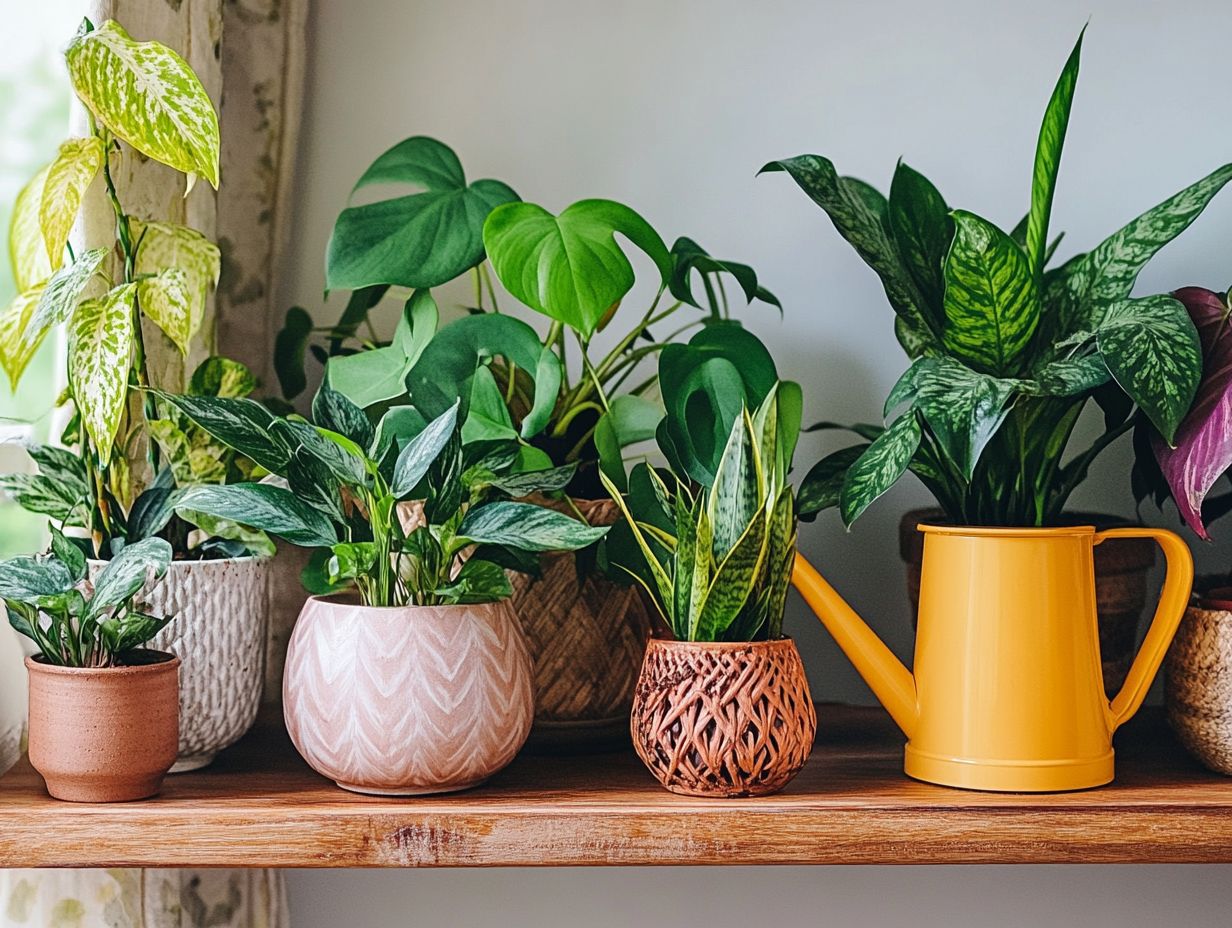
Some indoor plants that thrive with regular watering include pothos, peace lily, spider plant, Chinese evergreen, snake plant, arrowhead plant, and Boston fern.
How often should I water these plants?
These plants should be watered once a week or when the top inch of soil feels dry to the touch.
What types of light do these plants need?
Most of these plants prefer bright, indirect light but can also do well in lower light conditions.
Can I over-water these plants?
Yes, it is possible to over-water these plants. It is important to let the top inch of soil dry out between waterings to prevent root rot.
Do these plants require any special care?
These plants are generally low maintenance, but it is important to wipe their leaves occasionally to remove dust and keep them looking healthy.
Can I mix these plants in the same pot?
Yes, these plants can be mixed together in the same pot as long as they have similar watering and light requirements.
Ready to give your plants the care they need? Start today!

